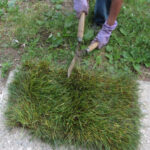The day was spent in observing at first hand how lawn sod was grown, harvested, delivered and laid. When we arrived a huge bare area in front of the new home of John Nunes was readied for sodding. When we left the area was clothed in rich green grass on which we walked. We learned the sod industry was born in England many years ago and the traditional English lawn was transferred to the USA by the English colonists. The basic industry grew in the eastern and Midwestern USA through the use of harvesting machines in pasture sod. The sod industry started slowly in California gained such in 1969, and has momentum that growers feel that it is just a matter of time before universal acceptance comes. The modern trend of using mature plants, grown in one to 15-gallon containers to landscape me home now holds true for established lawns as well. In addition to being an instant attraction, sod also represents immediate utility toy being hardy, wear resistant, and mature. Also, by using sod, only a very short period of critical maintenance is necessary during the period in which sod roots to the parent soil. So just like fee container grown nursery stock, it is mature, hardened, and after a few days can be used as if it were a year old, and like container stock it can be laid (planted) any time of the year it isn’t raining.
Laying Sod
Cal-Turf sod is palletized into lots of 500 square feet each. It can be placed with a forklift, close to the area to be sodded. Here are the basic procedures recommended by the growers:
1. Preparation of the lawn area should be similar to mat of a seed bed with two exceptions: 1 – do not rake the surface texture to the fineness recommended for seed and 2 – the surface grade should be approximately 1 ¼ inches below tie top of sidewalks, curbings, etc.
2. Scatter two pounds per 100 square feet of 16-20-0 ammonium phosphate plus sulphur. Cal-Turf includes this fertilizer in the cost of the sod and delivers it with the sod to make sure it is used before the sod is laid.
3. Having previously measured the area, have the sod pallets placed on the lawn by the Cal-Turf forklift according to the requirement of the area, or mark each pallet with a Cal-Turf sod marker. If the forklift has left tracks while placing pallets, rake in the tracks. The labor for raking in the tracks is a good deal less than wheeling the sod to the site.
4.Stretch a line through the longest points of the area to be sodded and start laying the sod along the string. Most of the garden writers were surprised to learn the string is stretched through the center of the plot, not along one side. Each roll of sod weighs approximately 20 pounds and contains a strip about fourteen inches wide. Cal-Turf cuts sod at various widths to fit the need) and 48 inches long.
5. After the first line of sod has been placed along the string the joints of the second line should be staggered similar to the joints of a brick wall. At Patterson, the second line of sod was lain on the opposite side of the string.
6. A reasonable amount of care should be taken to avoid spaces between the sod strips as they were laid. (The men at Patterson grasp the sod by the grass blades and pushed it firmly against the preceding row and end.) Water immediately supplied to newly laid sod is of extreme importance. The majority of the roots in the mature sod have been cut and left in the field from which the sod came. This reduces the possible reservoir from which the grass may draw its water. It is therefore important that the sod be kept moist to have continuous access to adequate water to sustain the rapid transpiration of the leaves during warm weather. On most warm days it is necessary to start watering before the job is complete to eliminate the possibility of wilting.
Water Needed
7. Immediately after sod has been laid and wet slightly to the point where only the sod itself plus about one inch of tin soil of the sod is wet, roll with a heavy hand or motorized roller flattening the entire area. This is the method used with bluegrass and dichondra as top dressing is impractical. On hybrid Bermuda and bent, sand can be raked into cracks and low places.
8. After rolling bluegrass or dichondra, the sod should be irrigated with sufficient water to thoroughly wet the soil column to a depth of 12 inches. This deep watering applies to bent and Bermuda after the top dressing and rolling.
The critical maintenance procedures needed immediately after sodding are irrigation and mowing. Irrigation should be frequent enough to avoid any wilting. Until the sod roots to the parent soil, two to three irrigations a day are recommended. The second very critical maintenance procedure is mowing. Mowing should start immediately as the grass begins to grow. It is advantageous to keep the growth at the recommended height of the particular variety used.
In mowing, the height of the cut depends to a large extent on the variety. Most bluegrasses should not be cut lower than 1 ½ inches. Never scalp or cut more than one half the top growth at one mowing. If circumstances force you to let the grass get longer, make two mowing about five days apart. Set the mower high enough to remove just one half the top growth. For the second mowing lower the cutting blade to me regular one and one-half inch length.
A regular deep watering program will give best results. The surf should not be kept wet but should dry out between waterings. Irrigate in the mornings if possible because cool wet evenings encourage disease. A weekly
watering is good under regular conditions, if it is hot or windy water more often. In shaded areas caused by trees or shrubs water more also because the lawn area will be in competition with the roots of these plants.
Well fertilized turf will be strong and vigorous. Applications of a complete fertilizer, once every two months is recommended during the growing season. A 10-6-4 or similar formula is good. Be careful not to overfertilize in mid-summer.
Sod is new to California and due to this, all of us tend to expect it to be a cure all. Since it does have an instant effect, it is often expected to do the impossible. True it is near perfect when it is laid but the care you give it after it is laid deter mines its perfection in the months and years to come. Cal-Turf sod is available through many of nurseries. Several of these nurseries will not only get the sod for you but will lay it for you should you be too busy.
http://www.emerysgarden.com/infosheets/lawn_planting.htm



